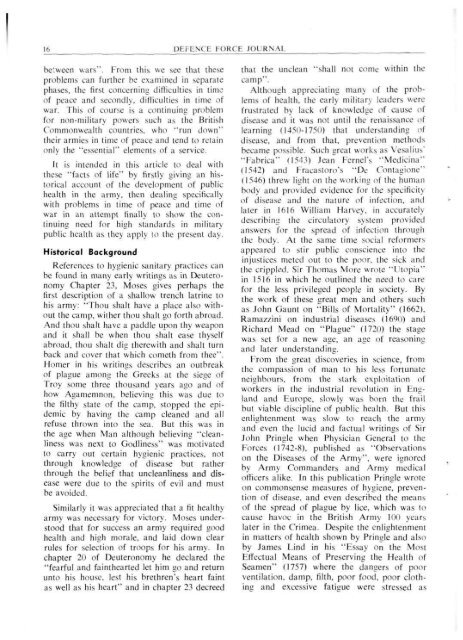ISSUE 3 : Mar/Apr - 1977 - Australian Defence Force Journal
ISSUE 3 : Mar/Apr - 1977 - Australian Defence Force Journal
ISSUE 3 : Mar/Apr - 1977 - Australian Defence Force Journal
Create successful ePaper yourself
Turn your PDF publications into a flip-book with our unique Google optimized e-Paper software.
16 1)1 i I N( I 1 ()K( 1 lot R\ \lbetween wars". From this we see that theseproblems can further be examined in separatephases, the first concerning difficulties in timeof peace and secondly, difficulties in time ofwar. This of course is a continuing problemfor non-military powers such as the BritishCommonwealth countries, who "run down"their armies in time of peace and tend to retainonly the •"essential" elements of a service.It is intended in this article to deal withthese "facts of life" by firstly giving an historicalaccount of the development of publichealthin the army, then dealing specificallywith problems in time of peace and time ofwar in an attempt finally to show the continuingneed for high standards in militarypublic health as they apply to the present day.HistoricalBackgroundReferences to hygienic sanitary practices canbe found in many early writings as in DeuteronomyChapter 23, Moses gives perhaps thefirst description of a shallow trench latrine tohis army: "Thou shalt have a place also withoutthe camp, wither thou shalt go forth abroad.And thou shaft have a paddle upon thy weaponand it shall be when thou shalt ease thyselfabroad, thou shalt dig therewith and shalt turnback and cover that which cometh from thee".Homer in his writings describes an outbreakof plague among the Greeks at the siege ofTroy some three thousand years ago and ofhow Agamemnon, believing this was due tothe filthy state of the camp, stopped the epidemicby having the camp cleaned and allrefuse thrown into the sea. But this was inthe age when Man although believing "cleanlinesswas next to Godliness" was motivatedto carry out certain hygienic practices, notthrough knowledge of disease but ratherthrough the belief that uncleanliness and diseasewere due to the spirits of evil and mustbe avoided.Similarly it was appreciated that a fit healthyarmy was necessary for victory. Moses understoodthat for success an army required goodhealth and high morale, and laid down clearrules for selection of troops for his army. Tnchapter 20 of Deuteronomy he declared the"fearful and fainthearted let him go and returnunto his house, lest his brethren's heart faintas well as his heart" and in chapter 23 decreedthat the unclean "shall not come within thecamp".Although appreciating man) of the problemsof health, the early military leaders werefrustrated by lack of knowledge of cause ofdisease and n was not until the renaissance ollearning (1450-1750) that understanding ofdisease, and from that, prevention methodsbecame possible. Such great works as Vesalius""Fabrica" (1543) Jean Fernel's "Medicina"(1542) and Fracastoro's "De Contagione"(1546) threw light on the working of the humanbody and provided evidence for the specificityof disease and the nature of infection, anillater in 1616 William Harvey, in accuratelydescribing the circulatory system providedanswers for the spread of infection throughthe body. At the same time social reformersappeared to stir public conscience into theinjustices meted out to the poor, the sick andthe crippled. Sir Thomas More wrote "Utopia"in 1516 in which he outlined the need to carefor the less privileged people in society. Bythe work of these great men and others suchas John Gaunt on "Bills of Mortality" (1662),Ramazzini on industrial diseases (1690) andRichard Mead on "Plague" (1720) the stagewas set for a new age, an age of reasoningand later understanding.From the great discoveries in science, fromthe compassion of man to his less fortunateneighbours, from the stark exploitation ofworkers in the industrial revolution in Englandand Europe, slowly was born the frailbut viable discipline of public health. But thisenlightenment was slow to reach the armyand even the lucid and factual writings of SirJohn Pringle when Physician General to the<strong>Force</strong>s (1742-8). published as "Observationson the Diseases of the Army", were ignoredby Army Commanders and Army medicalofficers alike. In this publication Pringle wroteon commonsense measures of hygiene, preventionof disease, and even described the meansof the spread of plague by lice, which was tocause havoc in the British Army 100 yearslater in the Crimea. Despite the enlightenmentin matters of health shown by Pringle and alsoby James Lind in his "Essay on the MostEffectual Means of Preserving the Health ofSeamen" (1757) where the dangers of poorventilation, damp, filth, poor food, poor clothingand excessive fatigue were stressed as
















